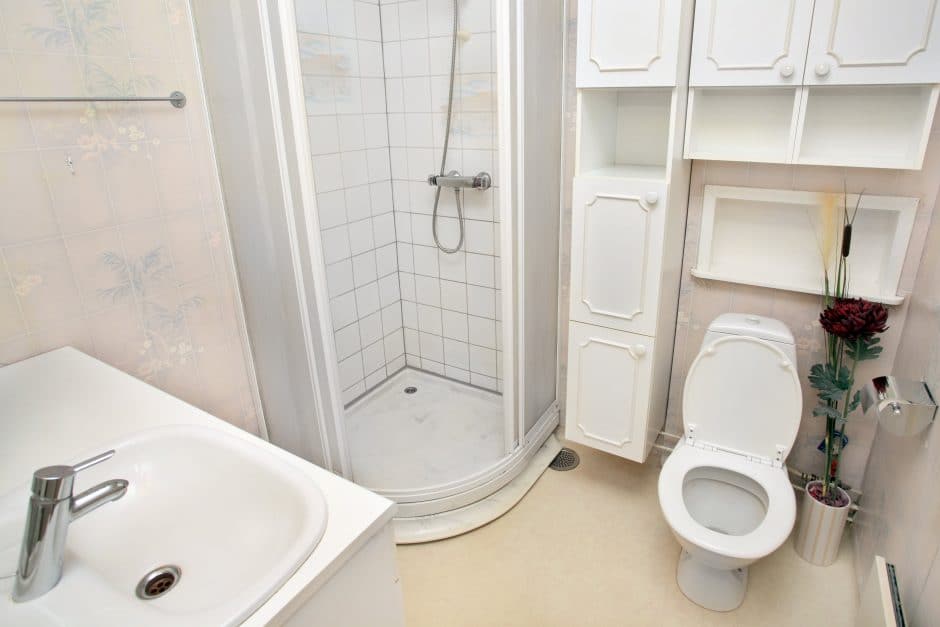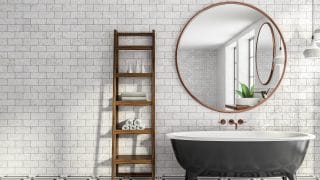
Whether it’s for a renovation or simply replacing an old, dirty-looking bathtub, if you’re working on a bathroom, you’ll need to install a shower pan. Shower pan to catch falling water from the showerhead and shower walls and direct it down a drain, which is crucial to avoid damaging the structure around the shower. The good news: learning how to install a shower pan is actually quite easy.
What is a shower pan?
A shower pan is essentially the foundation of the shower. It’s the portion of the shower that sits on the floor. It has a built-in drain and a slight slope that directs the water coming out of the showerhead to the drain. They’re typically pre-made from fiberglass, acrylic, or coated metal, which makes them long-lasting and capable of carrying quite a bit of weight. They can also be custom-made with specialized membranes, pan liners, and tiles, as well.
The pan serves as the shower base. The shower pan installs first, with the cement board and tiles or shower surround installed on top of the pan’s rim. This creates a cascading effect that prevents water from running behind the shower and into the walls.
With that, it’s clear to see that shower pans play a very important role. They serve as the waterproof barrier between the shower space and the porous materials around it like wood, drywall, and insulation. Without a shower floor pan, those materials would likely suffer from water damage and begin to mold or rot, potentially causing both health issues and structural weaknesses.
What are the advantages of shower pans?
When it comes to designing a bathroom, there are a lot of advantages to using a shower pan. From simplicity and customizability to weight and safety, there are plenty of reasons one might opt for a shower pan.
Space savings
Many smaller bathrooms don’t have the space for a full-size tub. Whether it’s an awkward layout or a repurposed space, the square footage simply doesn’t exist. In these cases, shower pans can come to the rescue.
Shower pans come in a variety of sizes and designs, such as those for alcoves and those for corners. The smallest of these pans measure 27 inches both deep and wide. While that’s not a lot of room for showering, it can make an otherwise non-functioning space into a full-functioning shower. This shower base will create the compact footprint that the rest of the shower will follow.
Simple to install
Installing a shower pan is actually quite easy, and most people can handle the job in a few hours. This is because manufacturers sell pre-made pans made for specific dimensions, and the toughest part of installing them is measuring the space correctly and figuring out the plumbing.
With the correct pan in hand, there aren’t any advanced techniques or trade secrets that a DIYer needs to know to install it. The pans themselves are also relatively lightweight and easy to maneuver, unlike a full-size tub.
Long-term safety
As folks begin to age, stepping in and out of a bathtub becomes more and more dangerous. With limited flexibility and waning balance, that hump between the bathroom floor and shower surface can cause a lot of accidents. Installing a shower pan minimizes the risk.
While shower pans do control the flow of water, they have much lower thresholds than bathtubs. Older folks and those with disabilities are typically able to navigate these barriers without issue. There are even shower pans designed specifically for wheelchairs or walkers.
Also, for folks who prefer to enter the shower and sit, shower pans offer much flatter surfaces for shower chairs. These pans forego the significant slopes and curved sides of a bathtub, allowing the person in the shower to sit comfortably without fear of the chair moving out from underneath them.
How to install a shower pan in 5 steps
Installing a shower pan is one of the simplest parts of a bathroom build or renovation, since shower pans come pre-made, meaning you only have to measure correctly and fit it in place.
Tools and Materials:
- Shower pan kit
- Level
- Tape measure
- Shims
- Jigsaw
- Power drill
- Plumber’s putty or silicone caulk
- Drain flange
- Adjustable pliers
- Exterior screws
- Sand mixture
- Bucket
- Trowel
- PVC primer, glue, and fittings
1. Decide on a pre-made or custom pan
The first step in installing a shower pan is to decide on a pre-made or custom pan. Pre-made pans are easier to install, while custom pans are more likely to bring a unique design to the bathroom.
Whether it’s for a renovation or simply replacing an old, dirty-looking bathtub, if you’re working on a bathroom, you’ll need to install a shower pan. Shower pan to catch falling water from the showerhead and shower walls and direct it down a drain, which is crucial to avoid damaging the structure around the shower. The good news: learning how to install a shower pan is actually quite easy.
What is a shower pan?
A shower pan is essentially the foundation of the shower. It’s the portion of the shower that sits on the floor. It has a built-in drain and a slight slope that directs the water coming out of the showerhead to the drain. They’re typically pre-made from fiberglass, acrylic, or coated metal, which makes them long-lasting and capable of carrying quite a bit of weight. They can also be custom-made with specialized membranes, pan liners, and tiles, as well.
The pan serves as the shower base. The shower pan installs first, with the cement board and tiles or shower surround installed on top of the pan’s rim. This creates a cascading effect that prevents water from running behind the shower and into the walls.
With that, it’s clear to see that shower pans play a very important role. They serve as the waterproof barrier between the shower space and the porous materials around it like wood, drywall, and insulation. Without a shower floor pan, those materials would likely suffer from water damage and begin to mold or rot, potentially causing both health issues and structural weaknesses.
What are the advantages of shower pans?
When it comes to designing a bathroom, there are a lot of advantages to using a shower pan. From simplicity and customizability to weight and safety, there are plenty of reasons one might opt for a shower pan.
Space savings
Many smaller bathrooms don’t have the space for a full-size tub. Whether it’s an awkward layout or a repurposed space, the square footage simply doesn’t exist. In these cases, shower pans can come to the rescue.
Shower pans come in a variety of sizes and designs, such as those for alcoves and those for corners. The smallest of these pans measure 27 inches both deep and wide. While that’s not a lot of room for showering, it can make an otherwise non-functioning space into a full-functioning shower. This shower base will create the compact footprint that the rest of the shower will follow.
Simple to install
Installing a shower pan is actually quite easy, and most people can handle the job in a few hours. This is because manufacturers sell pre-made pans made for specific dimensions, and the toughest part of installing them is measuring the space correctly and figuring out the plumbing.
With the correct pan in hand, there aren’t any advanced techniques or trade secrets that a DIYer needs to know to install it. The pans themselves are also relatively lightweight and easy to maneuver, unlike a full-size tub.
Long-term safety
As folks begin to age, stepping in and out of a bathtub becomes more and more dangerous. With limited flexibility and waning balance, that hump between the bathroom floor and shower surface can cause a lot of accidents. Installing a shower pan minimizes the risk.
While shower pans do control the flow of water, they have much lower thresholds than bathtubs. Older folks and those with disabilities are typically able to navigate these barriers without issue. There are even shower pans designed specifically for wheelchairs or walkers.
Also, for folks who prefer to enter the shower and sit, shower pans offer much flatter surfaces for shower chairs. These pans forego the significant slopes and curved sides of a bathtub, allowing the person in the shower to sit comfortably without fear of the chair moving out from underneath them.
How to install a shower pan in 5 steps
Installing a shower pan is one of the simplest parts of a bathroom build or renovation, since shower pans come pre-made, meaning you only have to measure correctly and fit it in place.
Tools and Materials:
- Shower pan kit
- Level
- Tape measure
- Shims
- Jigsaw
- Power drill
- Plumber’s putty or silicone caulk
- Drain flange
- Adjustable pliers
- Exterior screws
- Sand mixture
- Bucket
- Trowel
- PVC primer, glue, and fittings
1. Decide on a pre-made or custom pan
The first step in installing a shower pan is to decide on a pre-made or custom pan. Pre-made pans are easier to install, while custom pans are more likely to bring a unique design to the bathroom.
For this guide’s sake, let’s assume that the decision is a pre-made pan. However, many of the steps and techniques apply to custom pans as well.
2. Prepare the Subfloor
Start the process by preparing the subfloor. Check for strength and integrity, and attempt to remove any humps or irregularities before beginning the installation. Use the level to check the floor for level front-to-back and side-to-side. If the shower pan has feet (many do), measure and mark their locations on the floor, and add shims to adjust the space for level. Drill and screw these shims in place.
3. Dry-fit the tub
Dry-fit the new shower pan in the opening and check to ensure that the rim is level in all directions. The center will be sloped toward the drain, so it’s not a good indication of level—check along the rim of the pan. Once level, mark each of the studs at the height of the rim. If the manufacturer’s instructions indicate to do so, this is when you will drill a hole in the rim of the pan at each stud location.
Note the location of the drain. If the existing drain hole doesn’t line up, mark the new drain’s location on the subfloor. Remove the pan and cut out the drain with a jigsaw.
4. Install the flange
Before permanently installing the shower pan, it’s important to install the drain flange. Be sure to reference the pan’s instructions before this step as the plumber’s putty can damage some materials.
Disassemble the drain flange and separate the parts. Apply a rope of plumber’s putty around the underside of the drain, or apply a bead of silicone caulk, and push the drain into the shower pan. From the underside of the pan, place the foam gasket over the threads, followed by the cardboard or paper gasket, and then the tightening nut. Tighten the nut by hand before using the adjustable pliers to snug it down. Be sure to wipe away the excess putty or caulk.
5. Apply the sand and install the pan
Mix the sand compound with water according to the manufacturer’s instructions and apply it to the subfloor with a trowel to create a mortar bed. Carefully place the shower pan in place, shimmying it back and forth until the rim lines up with the marks on the studs.
For pans that require it, secure the rim to the joists with exterior-grade screws. Otherwise, carefully place a bag of cement or another heavy object in the middle of the shower to prevent the sand from heaving the pan upward while it dries.
Connect the pan to the shower drain system using the PVC fittings, primer, and glue. Each drain will be different, but in most cases, the flange will attach to the PVC drain pipe with a rubber friction gasket.
Finally, install the cement backer board for tile showers, or the fiberglass shower surround to finish the shower stall installation.
MT Copeland offers video-based online classes that give you a foundation in construction fundamentals with real-world applications, like installing windows and doors. Classes include professionally produced videos taught by practicing craftspeople, and supplementary downloads like quizzes, blueprints, and other materials to help you master the skills.






